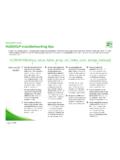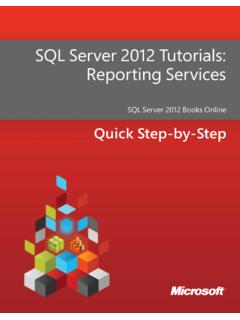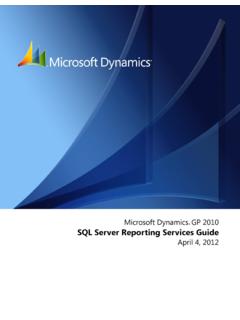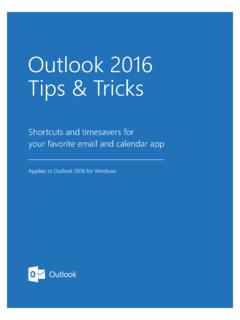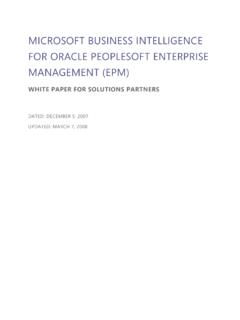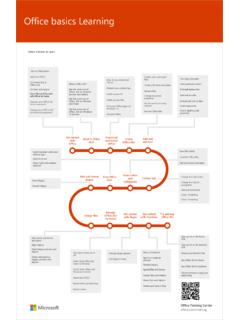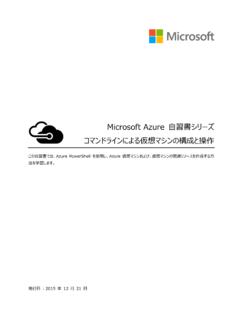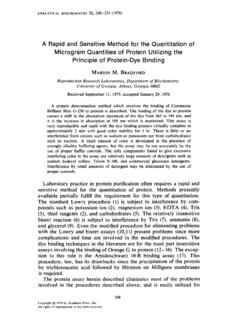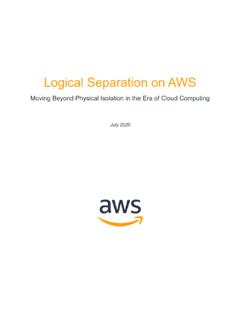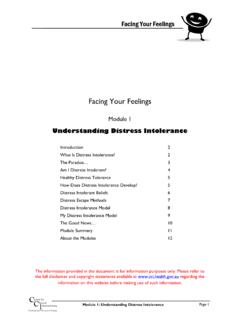Transcription of Page 1 Microsoft 365 Information Protection and Compliance ...
1 This topic is 1 of 8. Page 1. Microsoft 365 Information Protection and Compliance Capabilities Introduction Microsoft 365 includes a broad set of Information Protection and Compliance capabilities. For more Information about how Microsoft 365 can help financial services institutions meet security Together with Microsoft 's productivity tools, these capabilities are designed to help and Compliance regulations, see Key Compliance and security considerations for US banking and organizations collaborate in real time while adhering to stringent regulatory Compliance capital markets. frameworks. In these illustrations, Woodgrove Bank hosts two Teams environments for projects with different This set of illustrations uses one of the most regulated industries, financial services, to demonstrate participants. In each scenario, each Team's Microsoft 365 Group provides a security boundary for how these capabilities can be applied to address common regulatory requirements.
2 Feel free to membership, with Azure Active Directory enforcing multi-factor authentication and other adapt these illustrations for your own use. conditional access policies for Microsoft Teams. Woodgrove Bank Contoso (guest members). v Microsoft Teams Environment October 2020 2020 Microsoft Corporation. All rights reserved. To send feedback about this documentation, please write to us at This topic is 2 of 8. Page 2. High level Teams logical architecture A common scenario where Teams benefits financial services is when running internal projects or The Anti-money laundering project includes only Woodgrove Bank employees. The Virtual data room . programs. For example, many financial institutions have anti-money laundering and Compliance for project B includes guest members from Contoso. The Virtual Data room acts as a secure place programs in place.
3 In this illustration , Woodgrove Bank hosts two Teams Environments for to share data that can only be accessed by authorized users. Azure Active Directory also enforces projects with different participants. multi-factor authentication and other conditional access policies for guests. Woodgrove Bank Contoso (guest members). IT Department Syndicates Retail and Wealth v External Investors Management Financial Crime Private Equity Unit Firms Microsoft Teams Environment October 2020 2020 Microsoft Corporation. All rights reserved. To send feedback about this documentation, please write to us at This topic is 3 of 8. Page 3. Identify sensitive Information and prevent data loss Microsoft 365 allows all organizations to identify sensitive data within the organization through a Sensitivity labels combination of powerful capabilities, including Microsoft Information Protection (MIP), and Office The following scenario illustrates how sensitive Information can be labeled either through machine 365 Data Loss Prevention (DLP).
4 MIP enables organizations to classify documents and emails learning or manually (shown below through user prompting and education). DLP can scan these labels to intelligently by using sensitivity labels, applied manually or through machine-learning. enforce data loss prevention policies. Woodgrove Bank Contoso Microsoft Information Protection (MIP) Microsoft Teams Environment Automated labeling Sensitivity labels OneDrive for Business SharePoint Online User is prompted to label sensitive Information Exchange Online This message includes sensitive Information . OK. Continued on next page Data loss prevention Once sensitivity labels are applied across the data, DLP can be used to identify documents, emails, The following illustration demonstrates DLP enforcing policies for data that matches several sensitive and conversation by scanning these for the sensitivity labels.
5 It then enforces appropriate policies on Information types (Policy 1) and data labeled highly Confidential' (Policy 2). We see that if an attempt is this data and lets you monitor, protect, and prevent accidental sharing of sensitive Information . It also made to share data marked highly Confidential' outside of allowed recipients, DLP blocks the sharing helps users stay compliant without interrupting their workflow. of the Information and prevents data loss. Woodgrove Bank Contoso (guests). Microsoft Teams Environment Data Loss Prevention policies 1. 1. OneDrive for Business 2. SharePoint Online 2. Exchange Online 2. October 2020 2020 Microsoft Corporation. All rights reserved. To send feedback about this documentation, please write to us at This topic is 4 of 8. Page 5. Govern data and manage Compliance requirements for retention Retention policies and retention labels Microsoft 365 provides flexible capabilities to define retention policies and retention labels to intelligently Retention policy Retention label implement records-management requirements.
6 Retention settings that you configure can help Assigns the same retention settings Assigns the retention settings at an Compliance with industry regulations requiring you to for content at a container level: at How are they used? item level (folder, document, email). retain content for a minimum period of time, reduce risk site or mailbox level. in case of litigation or security breaches, and share knowledge in an effective, agile way. A single policy can be applied Labels are applied to individual items . You can use both retention policies and retention labels automatically to multiple or specific at Where are they such as documents, email, or videos at folder level. to assign retention settings. container levels for example, SharePoint applied? sites or group mailboxes. Both of these come with specific ways to help comply with rules defined by financial regulatory bodies such as SEC Rule 17a-4(f), which requires regulated entities to "Preserve the records exclusively in a non-rewriteable, If an item is edited, deleted, or moved, a Persistence of label/policy The retention label persists if the copy of the content is automatically data is copied or moved to a non-erasable format.
7 " Microsoft 365 accomplishes this retained as it existed when you applied different site or mailbox within that by applying a Preservation Lock to a Retention Policy or the retention settings. same M365 environment. Label Policy (in the case of Regulatory Record labels), which ensures that the policy cannot be turned off or Retention period is calculated from the age These support starting retention periods made less restrictive. Retention Policies and Regulatory Retention period settings from when content was labeled, or are of when content is created or modified, Record labels are touched upon in later illustrations not from when the policy is applied. event-based (in addition to the age of the (topic 5 of 8). content or when it was last modified). There is no limit to the number of retention labels that are supported for a tenant.
8 However, 10,000 is the This is implemented through a Meeting regulatory This is implemented through a special maximum number of policies that are supported for a retention policy with a Preservation Compliance requirements type of label called Regulatory records tenant and these include the policies that apply the Lock applied to it. Administrators with Preservation Lock applied to the cannot disable or delete a policy once associated label policy. Regulatory labels. a preservation hold is applied. record labels must be applied by the end user. The broad differences between these two methods are shown in the facing diagram. Retention labels and Retention policies can be utilized Continued on next page together to help you meet your Compliance requirements. Retention policy application A retention policy lets you proactively retain, delete - or both retain and then delete - content very to retain content indefinitely or for a specific number of days, months, or years.
9 The retention period is efficiently by assigning the same retention settings for content by container at a site or mailbox level. calculated from the age of the content (from when it was created or modified), not from when the A retention policy can support multiple containers, but a single retention policy cannot include all retention policy is applied. The following diagram shows Retention policies being applied to data in supported containers (Teams, SharePoint etc). When you configure a retention policy, you can choose different containers in the M365 environment. Woodgrove Bank SharePoint Site Microsoft Teams Retention Policies OneDrive for Business SharePoint Online Exchange Online Audit logging notes changes made to policy Continued on next page Retention label application Retention labels help you retain and delete data at an item level (document, email, or folder).
10 After Retention labels can also be used to mark items as a record or a regulatory record When this happens labels are created, you will create a retention label policy to specify the locations where these labels and the content remains in Microsoft 365, the label places further restrictions on the content that helps can be applied. A retention label can be applied automatically based on sensitive Information types, you meet regulatory requirements. Retention labels don't persist if data is moved outside your Microsoft keywords or properties, a trainable classifier, a SharePoint Syntex document understanding model, or 365 tenant. as a default label in SharePoint. End-users can also manually apply labels to SharePoint documents and Exchange emails. Woodgrove Bank Create Retention Labels SharePoint Site Microsoft Teams OneDrive for Business SharePoint Online Exchange Online Audit logging notes changes made to labels October 2020 2020 Microsoft Corporation.


